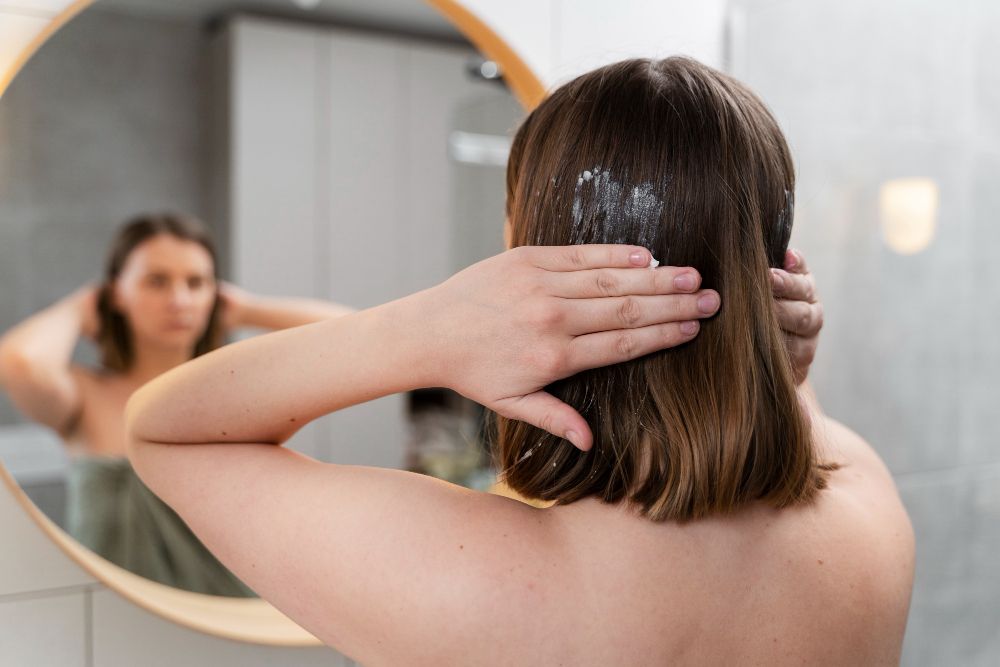- Home
- Trend
- Weight Loss Strategies
- Acne Tips
- Hair Health Information
- Blemish Removal Tips
- Acne Scar Removal Tips
- Muscle Building Techniques
- Intimate Care Tips
- Postpartum Intimate Care
- Eye Bags Wiki
- Tips for Face Slimming
- Secret of Permanent Hair Removal
- Breast Enlargement Tips
- Cure to Snoring
- Marionette Lines
- Skin-Tightening Secrets
Conditioning is a crucial step in every woman’s haircare routine. Focusing solely on cleansing your hair and scalp isn’t enough—if you skip the conditioning process or use the wrong products, your hair could become frizzy, dry, brittle, or even prone to breakage and hair loss. The market is flooded with various haircare items—conditioners, masks, oils, and leave-in treatments—so it's important not to treat haircare lightly. To achieve smooth, healthy-looking hair, you need to follow a proper care routine and maintain a healthy scalp.
1. Haircare 101: How to Identify Your Hair Type

You’ve probably seen countless influencers and celebrities recommend their go-to haircare products, but have you ever tried one of their holy grails only to see no noticeable results—or worse, end up with greasy scalp or breakouts?
That’s because understanding your own hair and scalp condition is a must before choosing any haircare product. What works for others may not work for you!
Hair types generally fall into dry, oily, and normal categories, but they can also be classified as either moisture-deficient or oil-deficient. Knowing where you fall makes it easier to target specific problems like frizz, brittleness, or limp hair.
Hair Type 1: Moisture-Deficient
If your hair is prone to static, frizz, or looks dull and lacks shine, you’re likely dealing with moisture-deficient hair.
The simplest solution? Drink more water daily to keep your body—and your hair—well hydrated. When choosing products, go for those with intense hydrating ingredients to prevent knots and dry scalp flakes.
Hair Type 2: Oil-Deficient
If your ends are noticeably lighter in color, prone to tangling, splitting, or even breakage, your hair likely lacks oil.
Focus on replenishing oils, especially on the ends. Hair oils are great for sealing moisture and preventing split ends and breakage. Also, steer clear of overly stripping shampoos, as they can worsen dryness by removing natural oils.
Hair Type 3: Lacking Both Moisture and Oil
If your hair has all of the issues above, then it's both oil- and moisture-deficient. In this case, a solid haircare routine is essential!
In addition to hydrating and nourishing the hair, trim damaged ends regularly. Pre-shampoo treatment with a hydrating spray near the roots can also boost your routine.
2. Why Use Haircare Products?

Think of your scalp as an extension of your facial skin—just as you wouldn't rely on face wash alone for skincare, shampoo alone isn't enough for hair. Without proper conditioning, you risk dryness, frizz, split ends, and breakage.
Hair masks, conditioners, and oils offer additional nourishment. Like serums or moisturizers for your skin, these products feature smaller, concentrated molecules that penetrate deeper into the hair shaft, repairing damage and restoring shine.
Plus, after shampooing, your hair cuticles are open. This is the best time for nutrients to sink in—if you skip conditioner, the cuticles won’t seal, leaving your hair vulnerable to damage.
免費體驗
F8 Hair Regrowth Treatment
1 Minute Self-Registration
Date should not be before minimal date
3. Types of Haircare Products
Once you’ve figured out your hair type, it’s time to choose the right products. But with shelves full of options—masks, conditioners, oils, heat protectants—it’s easy to feel overwhelmed. Here's a breakdown of the essentials:
Haircare Product 1: Hair Mask
Think of a hair mask like a facial mask—for your hair. It delivers intense moisture and smoothness in a short amount of time. Compared to conditioner, hair masks have smaller particles and offer more potent repair, making them ideal for emergency rescue.
How to use: Apply after shampooing. Massage it gently into your hair with your fingertips, wait 5–10 minutes, then rinse with warm water.
Haircare Product 2: Hair Oil
Best for those with dry, split ends. Hair oils are deeply nourishing and can instantly restore shine and smoothness.
Note: Avoid applying oil to the scalp—it’s too heavy and may clog hair follicles, causing inflammation or acne. Instead, apply sparingly to the ends and mid-lengths using a gentle massaging motion.
Haircare Product 3: Conditioner
Conditioners work like lotion for your hair—they prevent moisture loss and provide daily hydration. While not as intensive as masks, they’re a vital step in any routine and safe for daily use.
Tip: Apply from mid-length to ends and avoid the roots to prevent clogged follicles.
4. How to Choose the Right Conditioner?
Since conditioner can be used daily, it’s important to pick one that matches your hair’s needs. Here’s how to choose based on your hair type:
For Frizzy Hair:
Choose conditioners with silicones. Though often debated, silicones effectively smooth frizz and reduce static by sealing the cuticle. Just avoid applying directly to the scalp.
For Fine or Limp Hair:
Opt for plant-based oils like coconut, olive, almond, or camellia oil. These hydrate without weighing hair down and help maintain bounce and elasticity—great for holding a style.
For Damaged Hair:
Look for glycerin, collagen, honey, or plant oils—all of which restore moisture and balance oil levels. If you don’t mind silicones, those can provide an added layer of protection and smoothness.
For Color-Treated Hair:
Go for conditioners with hydrolyzed keratin and citric acid. Keratin repairs damaged hair, while citric acid restores a slightly acidic pH to close the cuticle, bringing back shine and smoothness.
For Sensitive Scalps:
Avoid products with silicones, preservatives, or coal tar. These may irritate delicate scalps and lead to hair follicle damage and hair loss. Look for mild, fragrance-free formulas instead.
5. Stylist-Approved Hair Mask Routine for Smooth, Silky Hair
Many people don’t see results from hair masks—or worse, get breakouts on their backs afterward. That’s likely due to incorrect application. Follow these pro tips:
Step 1: After washing your hair, gently squeeze out excess water until it’s no longer dripping. Step 2: For long hair, use a coin-sized amount (about the size of a $5 coin); for short hair, use half that. Spread evenly between your palms. Step 3: Bend slightly forward while applying to avoid getting product on your back. Step 4: Start with the ends, work your way up, and gently detangle mid-lengths with your fingers. Press your palms over the crown to help the warmth push nutrients into the roots. Step 5 (Pro Tip!): Clip your hair up after applying to help distribute the mask evenly and allow longer absorption time. Rinse thoroughly with warm water.
免費體驗
F8 Hair Regrowth Treatment
1 Minute Self-Registration
Date should not be before minimal date
6. Master the 3-Step Home Haircare Routine to Rescue Frizzy Hair
Many women are unsure about the correct order of haircare products. Ideally, salon treatments like deep oil therapy or Hair Spa sessions are great, but they can be time-consuming and expensive. If you’re short on time or budget, here's how to do it yourself at home:
Step 1: Deep Oil Treatment
Professional oil treatments usually involve a steamer, but at home you can use products with proteins, lipids, and silicones to smooth lifted cuticles.
Step 2: DIY Hair Spa
This DIY routine is great for quick recovery at home using just a hair mask and oil.
• Step 1: Comb and rinse hair with warm water (35–40°C).
• Step 2: Exfoliate the scalp with a scrub, massage gently for 2–3 minutes, then rinse.
• Step 3: Apply hair oil, wrap hair in a warm towel, and let it sit for 15–20 minutes.
• Step 4: Rinse thoroughly with shampoo, ideally twice.
• Step 5: Apply a deep-conditioning hair mask, leave it on for 20 minutes, then rinse to reveal silky, hydrated strands.
Step 3: Daily Haircare Order
For normal care: Shampoo → Hair Mask (if needed) → Conditioner → Hair Oil before blow-drying to prevent heat damage.
7. When Home Treatments Aren’t Enough—Try a Professional Hair Regrowth Treatment
If your scalp or hair is severely damaged, at-home care might not cut it. Healthy hair starts with a healthy scalp. If your scalp is sensitive or weakened, achieving volume and shine will be tough.
That’s where Perfect Medical’s F8 Hair Regrowth Treatment comes in. Using 650nm LLLT low-energy laser technology, this treatment penetrates deep into the scalp, revitalizes follicles, and stimulates healthy regrowth. It also removes dead skin and buildup to keep pores clear.
The best part? There’s a free trial session available—just register in a minute to experience the F8 treatment and regain smooth, shiny, voluminous hair without the hassle.
Register Today: Perfect Medical F8 Hair Regrowth Treatment免費體驗
F8 Hair Regrowth Treatment
1 Minute Self-Registration
Date should not be before minimal date
FAQ

What’s the difference between a hair mask and conditioner?
A hair mask is like a facial mask—intense, short-term nourishment. It penetrates deeper and is best for rescue care. Conditioner is like a daily lotion that keeps hair hydrated and protected, but is less intensive.
What should I use before a hair straightener?
Always apply a heat-protectant oil or spray first. This prevents the heat from stripping your hair’s natural moisture and causing breakage.
What products help with frizzy hair?
Choose conditioners with silicone to seal the cuticle and prevent static. Just avoid applying them to the scalp.
Why do I get scalp acne after using conditioner?
Conditioners with silicone can clog hair follicles if not rinsed properly, leading to buildup and breakouts. Try a silicone-free option and make sure to rinse thoroughly.
How should I use a hair mask?
After shampooing, towel dry your hair. Apply the mask from ends upward, avoiding the back to prevent acne. Clip your hair up, leave the mask on, and rinse thoroughly after 10–20 minutes.









